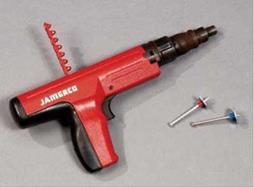SLIDING COMPOUND-MITER SAW
A 10-in. sliding compound-miter saw is the ultimate tool for a wide range of finish work. The extended crosscut length, combined with adjustable angle and bevel settings, allows complicated cuts in larger materials such as 6-in. by 6-in. deck posts, 10-in.-wide siding boards, and large crown molding.
Moderately priced and incredibly useful, a power planer can plane down studs to create a flat plane for drywall, trim a little off an exterior door, and quickly cut a slot so the nailing flange of an electrical box is flush to the edge of a stud (see the photo on p. 167).
Renting a h-in. right-angle drill will let you avoid burning out your own drill while roughing in plumbing and electrical runs. The right-angle drill is a godsend in the tight spaces between framing members, and the drill’s long handle gives you more leverage to control the torque of this slow-drilling powerful machine.
When drilling through framing, self-feeding, double-spiral bits clear wood well, but use a hole-cutting bit when bigger holes are required. Whatever bit you use, wear goggles and watch for nails. The better right-angle drills will have a clutch that disengages if the bit meets a certain level of resistance.
It may take 20,000 to 30,000 nails just to sheath an average house. Add to that the nails needed
![]()

 for framing, roofing, and shingling, and you can begin to imagine the number of hammer strokes required. Pneumatic nailers, commonly called nail guns, can reduce those strokes to a small fraction.
for framing, roofing, and shingling, and you can begin to imagine the number of hammer strokes required. Pneumatic nailers, commonly called nail guns, can reduce those strokes to a small fraction.
Control of the workpiece is the other big advantage of these nailers—with a hammer and nail, you need one hand for each. A pneumatic nailer delivers the nails, giving you a free hand to hold a stud or top plate in place. The nail goes in quickly without requiring hammer blows that cause the wood to “drift.”
And unlike hammer heads, pneumatic nailers won’t slip and ding expensive pieces of trim. Consequently, among professionals, pneumatic finish nailers have all but replaced the hand nailing of door and window casings.
There are framing nailers, finish nailers, and brad nailers (also called pin tackers). These nailers are powered by air hoses running to a compressor and calibrated by a pressure adjustment on the nailer. Staff at rental companies can explain such adjustments as well as safety features and correct operation.
Hard hats, safety glasses, and hearing protection are musts.
Potentially very dangerous, powder-actuated tools are useful for shooting nails into concrete, as when framing an interior wall on a concrete slab or securing pressure-treated lumber to a foundation wall. But such connections need to be nonstructural. Engineers specify bolts instead for all structural connections to concrete.
A reputable rental company will demonstrate the tool’s safe use, describe (and rent) safety equipment, answer your questions, and supply appropriate cartridges and drive pins. Some local codes prohibit renting powder-actuated tools to nonprofessionals.
When using this tool, wear safety glasses, hearing protection, and a hard hat.
A rotary hammer is also known as a hammer drill or RotoHammer®, after a brand name. On
the hammer setting, the tool punches as it turns, somewhat like a jackhammer.
Smaller hammer drills (И in.) typically offer two settings: rotation only and hammering with rotation. Such drills are adequate to drill small holes in concrete, for anchoring door thresholds to slabs and for predrilling pilot holes for masonry screws.
Larger hammer drills (U2 in.) usually offer only hammering with rotation. If you need to drill dozens of M-in. holes for standard %-in. anchor bolts, this is the tool. Get a model with padded handles as well as vibration reduction.
Wear safety glasses, hearing protection, heavy gloves, and hard hat.
CONCRETE BREAKER AND COMPRESSOR
Whenever you need to replace defective concrete, change the configuration of foundations, or get down to soil level to put in new drainage, rent a concrete breaker (see the photo on p. 215) and special high-volume compressor.
Use a gasoline-powered soil tamper tool before you pour a concrete slab, lay a brick walk, and so on.
Although you can rent Dumpsters by the day or week, carefully plan (and stick to) demolition schedules so you fill and get Dumpsters removed as quickly as possible. Other people’s debris has a way of filling your Dumpster when it sits too long, so don’t even order one until you’re well into tearout and have accumulated a half week’s worth of debris.
If you’re demolishing masonry, rent a “low boy,” which is a small unit (10 cu. yd.) specially built for the great weight of concrete, brick, and the like. For other jobs, rent the largest size available, usually 20 cu. yd. Be advised that you’ll also pay for the dumping fee the company must pay to your municipality.
Nailer TRIGGERS
Pneumatic nailers have several types of triggers. The safest is a restrictive trigger, which you must squeeze and release to shoot a nail. A second type, a bounce-fire trigger, shoots a nail each time you depress the gun’s nosepiece. Bounce-fire triggers are usually favored for sheathing, which requires a lot of 8d nails (2У2 in. long) spaced relatively close to one another. Until you become accustomed to nailers, restrictive triggers are far safer.






Leave a reply